This evening the MICHELIN Guide announced the 2025 selection for the Northeast Cities at a ceremony held at the Kimmel Center for the Performing Arts in Philadelphia. This marked the first year for Boston and Philadelphia’s restaurants to be included in the newly minted regional Guide. The other pre-existing cities included in this edition of the Guide are Chicago, New York and Washington, DC.
Overall, the full selection, including Bib Gourmand restaurants and Recommended eateries, boasts 664 restaurants with 64 cuisine types reflected. In New York, Japanese restaurant, Sushi Sho, was promoted to Three MICHELIN Stars and Korean eatery, Joo Ok, was promoted to Two MICHELIN Stars. Chicago’s Kasama was promoted to Two MICHELIN Stars, while Feld earned its first MICHELIN Star in addition to a Green Star.
In the first-ever selection for Boston, 311 Omakase brought home One MICHELIN Star and the city welcomed six Bib Gourmands to its roster. Philadelphia’s inaugural selection included three One MICHELIN Star restaurants including: Friday Saturday Sunday, Her Place Supper Club and Provenance. Additionally, Pietramala in Philadelphia joined the Green Star community.
“This year marks a momentous occasion for the Northeast Cities to come together and celebrate the exceptional talent across the restaurant communities in these five cities,” said Gwendal Poullennec, International Director of the MICHELIN Guide. “We are thrilled to celebrate the first-ever selections in both Boston and Philadelphia and welcome several new restaurants into the MICHELIN Star family. Our anonymous Inspectors were able to witness and taste the passion these industry professionals brought to the table. Congratulations to all the chefs and restaurant teams honored tonight.”
Here are the new MICHELIN Star restaurants, with Inspector notes from each (Inspectors’ comments in full on the MICHELIN Guide website and mobile app):
Three MICHELIN Stars
New York
Sushi Sho (Japanese)
In the shadow of the New York Public Library, Chef Keiji Nakazawa exemplifies mastery of the highest order. His omakase is utterly unique. The progression ebbs and flows with a dazzling variety of fish, shellfish, vegetables and more; applying an extensive use of fermentation techniques first developed in Japan. Reverent, while also honoring flexibility and evolution, the chef and team are constantly honing their craft. The setting is its own marvel and features a Hinoki counter flanked by towering ice boxes fronted with carved wood doors, while all around, the kitchen and service teams work in perfect tandem. In total, the pace, breadth and persistence of excellence that unfolds here will impress even the most experienced sushi enthusiasts.
Two MICHELIN Stars
Chicago
Kasama (Filipino)
Drawing its name, fittingly, from the Tagalog word for “together,” Kasama unites the culinary talents (and fine dining pedigrees) of husband-and-wife team Tim Flores and Genie Kwon. Flores’s background provides inspiration for this modern interpretation of Filipino cuisine, while Kwon’s pastry training elevates the sweet side of things. In a simple space, the two cook with striking originality. Homey traditional preparations are reimagined in elegant, inventive ways, as in an “adobo” of mussels and wild mushrooms that balances tangy, sweet and savory. Bold, original sauces like peanut with shrimp paste have few equals. Desserts, like a “mais con yelo” that features sweet corn semifreddo and milk granita, are every bit as satisfying.
New York
Joo Ok (Korean)
In the beating heart of Koreatown, take a freight elevator up 16 stories to find this elegantly appointed retreat. Echoing a traditional Korean home, guests are welcomed with snacks and drinks before being escorted to the dining room, where a minimalist design is juxtaposed with views of the Manhattan skyline. Chef Shin Chang-ho offers a Korean tasting menu that feels both traditional and contemporary and exudes calm, collected refinement. A deconstructed pheasant mandu with foie gras and morels is a remarkable feat while spotted prawn and geoduck clam is dressed with vivid green perilla oil made in house from imported seeds. Desserts and confections are beautiful to behold and equally delicious to finish. A cup of warm sunchoke tea brings the evening to a close.
One MICHELIN Stars
Boston
311 Omakase (Japanese)
Located on the ground floor of a South End rowhouse, this intimate chef’s counter is the vision of Chef Wei Fa Chen. Pale walls and light wood provide a blank canvas to show off the chef’s seasonal selection of ceramic platters (from Kyoto and Asheville), custom-made tatami coasters, and thoughtfully crafted cuisine. The chef’s omakase features impressive nigiri showcasing high-quality product, much of it imported from Japan; and the range of fish could include fluke, striped beakfish and goldeneye snapper. Cooked items precede the sushi and highlight a particular cooking method, such as delicately crunchy fried longtooth grouper with ponzu sauce or a simmered bowlful of amadai and abalone in dashi.
Chicago
Feld (Contemporary)
It may be in the city—Chicago’s Ukrainian Village neighborhood, to be specific—but Feld is focused on the farm, sourcing most products from within a four-hour radius. Their passion is clear, and all eyes are trained on the kitchen team as they work in the center of the room. Chicago native Chef Jacob Potashnick highlights in-season products, and the same ingredient may be highlighted in different forms, like raw asparagus with a cured lemon emulsion, tempura fried or as a juice accompanying fresh cheese, or in main dishes like poached Maine halibut with a maitake mushroom purée, maitake mushroom and thyme foam and a piece of grilled maitake mushroom. If the weather cooperates, sit by the fire pit in their backyard and spy their sour cherry trees, which naturally also appear on the menu.
New York
Bridges (Contemporary)
The talented Sam Lawrence is sure to impress diners at this welcoming restaurant in the heart of Chinatown. The warm, amber-toned dining room possesses the ease and comfort of a bistro, while the kitchen cooks with noteworthy levels of drive and ambition. The tight menu is sparse on words and doesn’t fit neatly into the box of any one cuisine but know that inspiration and originality are in proper supply. Does cured tuna with black trumpet mushrooms and dates work? It sure does. The savory tart filled with a lush Comté custard dressed with creamy morels is a delight. Desserts like the chocolate hazelnut tart, are a thrill, and much like the restaurant, has all the makings of a classic. Service is both relaxed and attentive.
Huso (Contemporary)
Those who recall Chef Buddha Lo’s cozy back room on the Upper East Side will take delight in its stunning reincarnation. Like before, the entrance is a caviar shop and further in, find a restaurant that is fully realized with all the bells and whistles. Flowing white drapes, big windows and generously spaced tables cut an elegant, sophisticated figure in cool TriBeCa. Refined and polished, the tasting menu deploys caviar in a sensible manner alongside a host of finely calibrated sauces. Ora King salmon with cream and croutons makes for an astute start, as well as one particularly clever foie gras and brioche preparation. Big spenders can jump for the luxury supplements, but such expense is not essential to see the full talents of this kitchen.
Muku (Japanese)
It’s intimate, with counter seats for around ten, but this ambitious restaurant punches above its weight. The kaiseki-inspired menu highlights goho, or the Japanese rule of five, featuring five distinct cooking techniques from raw and grilled to simmered, steamed and fried. Seasonality is paramount, and these meticulous dishes showcase an impressive mastery of flavors. Shabu shabu with Japanese wagyu and a deeply flavorful broth; gohan featuring rice with finely diced chicken and maitake mushrooms; soba noodles made with buckwheat from the chef’s hometown—each dish displays confidence and precision. Mizugashi with diced crown melon, sake lees ice cream and honeydew soda foam is flawless, and accompanied by a smoked green tea, it’s an unforgettable ending.
Yamada (Japanese)
Chef Isao Yamada’s life’s work has been kaiseki, and this impressive venture adds an interesting facet to the roster of high-end Japanese dining in New York. Diners here are treated to a personal expression of seasonality, with each course highlighting a distinct method of preparation. An array of sashimi bears impressive fish; the owan, or clear soup course, may brim with King crab dumplings; and the gohan, or rice course, may be a seasonal delight folded with Maine lobster, Nantucket sweet corn and maitake mushrooms from the Catskills. The chicly spare room is reserved for a handful of diners at an L-shaped counter, while the pale, earthy aesthetic is enhanced with ikebana and a windowed Japanese dry garden.
Philadelphia
Friday Saturday Sunday (American Contemporary)
And Wednesday and Thursday. Chef Chad Williams and his wife Hanna, both Philadelphia natives, took over this veritable institution in 2016 and then pivoted to offering a set multicourse menu when reopening after the pandemic. It works well, as it allows Chad to provide a balanced, varied and consistent experience to all. Thanks to skilled technique, just the right amount of innovation and an innate understanding of the luxury ingredients he uses, his dishes fill the mouth with flavor and succulence. His delicious crispy sweetbreads will convert any skeptic; quail with pâte plays with texture, and the New York strip is a lesson in expert seasoning. There’s a great cocktail bar on the first floor; the long, narrow, lively and warmly run restaurant is up a steep flight of stairs – and those stairs will seem even steeper when it’s time to leave. Expect an atmosphere as spirited and enjoyable as the food.
Her Place Supper Club (European Contemporary)
The name says it all, as Amanda Shulman’s cozy little spot was born out of her love for cooking for friends and has that warm and welcoming supper club vibe. Diners may get their own table but there’s a real communal feel at play here; everyone is served at the same time after Amanda has explained to the room the make-up of each dish and perhaps the influence behind it. Her multicourse set menu changes every two weeks, and her accomplished and beautifully balanced cooking comes with French and Italian accents. It also boasts a welcome lightness of touch, so you leave feeling sated rather than overwhelmed, although you can choose some extra dishes as add-ons if you wish. Her sauces, whether a barigoule served with brioche-crumbed trout, or the beurre blanc that accompanies the homemade chitarra pasta with clams, are real strengths. There are two seatings (at 6 p.m. and 8.30 p.m.) so do arrive on time.
Provenance (Contemporary)
Chef Nicholas Bazik and his team know exactly what they’re doing in this historic row house. In full view of the counter, they deliver a high-wire, high-stakes performance defined by precision, harmony, and, of course, taste. Korean and French influences come and go with this elaborate tasting menu where special soys, vibrant oils and glossy sauces give wonderful dimension to pristine seafood and dry-aged proteins. Think Japanese tuna with whipped tofu, puffed sorghum and chili oil or brown butter hollandaise with country ham, caviar and cauliflower. The ideas are original, the flavors bold. Such creativity hews closely to the seasons, and even a salad can arrive as a revelation. All the while, service is seamless and warmly choreographed.
MICHELIN Green Star
Green Star: Two New Restaurants Highlighted for Their Inspiring Visions
The MICHELIN Green Star editorially highlights restaurants that have inspired and impressed Inspectors with their committed vision for the future of gastronomy. By shaping a community of innovative establishments driven to pursue progress in the role of restaurants, the MICHELIN Green Star fosters dialogue and collaboration, encouraging establishments to inspire and evolve together.
Two new restaurants have newly captured the Inspectors’ attention for their inspiring visions: Feld in Chicago and Pietramala in Philadelphia. At Feld, the team focuses on responsible sourcing, which means working only with products that are in season and purchased through small sustainable farmers and producers. They also reduce food waste through fermentation and preservation practices. Pietramala is an entirely vegan restaurant and all of their products are sourced from independent, organic farms nearby. The team also works with local producers to utilize their waste or excess, using spent yeast from a local brewery to make garum, tomato seconds to make tamari and spent sunflower seeds from a local oil mill to make miso.
These newly highlighted restaurants join the seven establishments already recognized for continuing to impress the Inspectors in Chicago, New York and Washington, D.C. Together, they form a community deeply committed to presenting another vision of gastronomy.
Bib Gourmand
The MICHELIN Guide Inspectors gave 30 new restaurants the Bib Gourmand distinction, which recognizes eateries for great food at a great value. The full list of new Bib Gourmands can be found below.
Northeast Cities’ 2025 Bib Gourmand restaurants
NOTE: The list below only includes “new” Bib Gourmands for the 2025 selection. The full list, including retaining Bib Gourmands for Chicago, New York and Washington, D.C., can be found on guide.michelin.com.
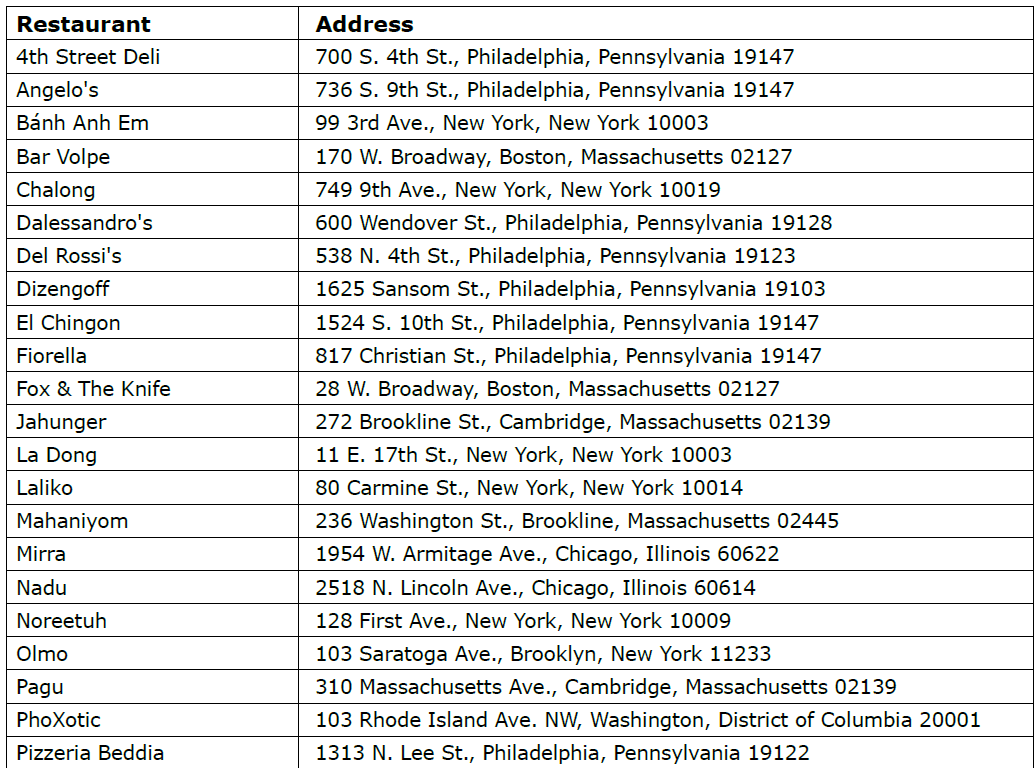

MICHELIN Special Awards
In addition to the Bib Gourmands and Stars, the Guide announced five Special Awards:
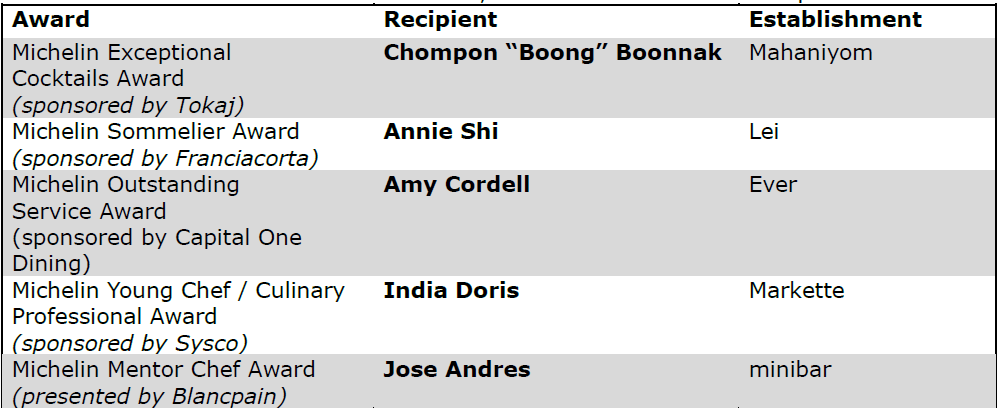
The MICHELIN Guide Ceremony is presented with the support of Capital One.
Hotels
The restaurants join the MICHELIN Guide selection of hotels, which features the most unique and exciting places to stay in the Northeast and throughout the world.
Each hotel in the selection has been chosen by MICHELIN Guide experts for its extraordinary style, service and personality — with options for all budgets — and each can be booked directly through the MICHELIN Guide website and app. The selection features the Northeast Cities’ most spectacular hotels, including the grand Langham Hotel (Two MICHELIN Keys) in Boston; a charming classic like The Rittenhouse (One MICHELIN Key) in Philadelphia; and the downtown favorite Soho House New York.
The MICHELIN Guide is a benchmark in gastronomy. Now it’s setting a new standard for hotels. Visit the MICHELIN Guide website, or download the free app for iOS and Android, to discover every restaurant in the selection and book an unforgettable hotel.

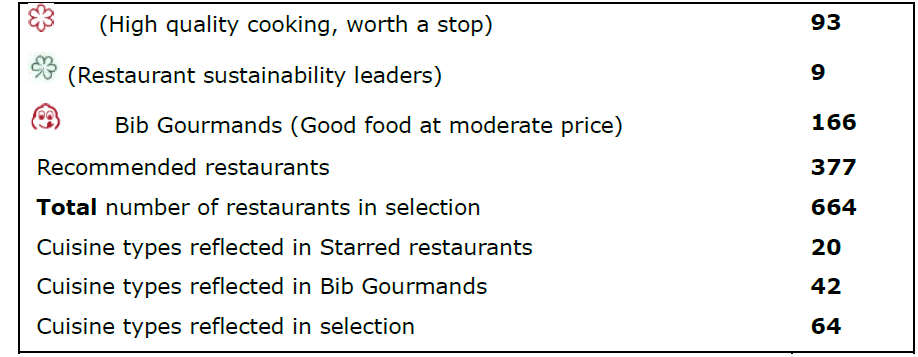
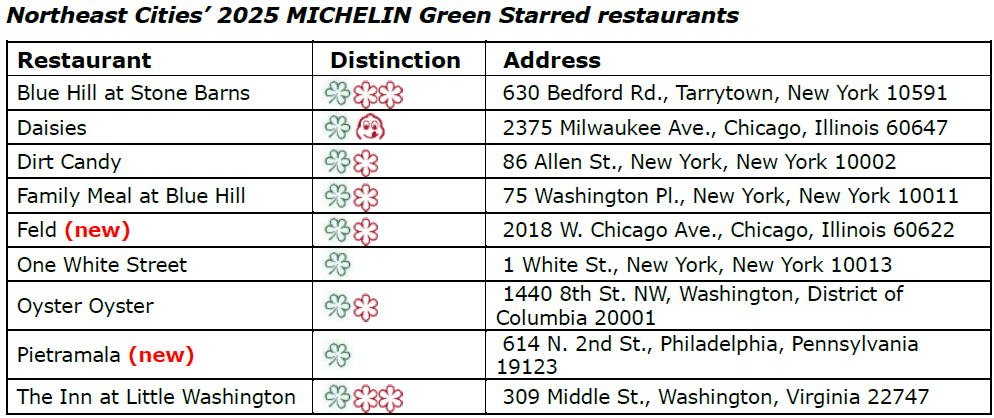
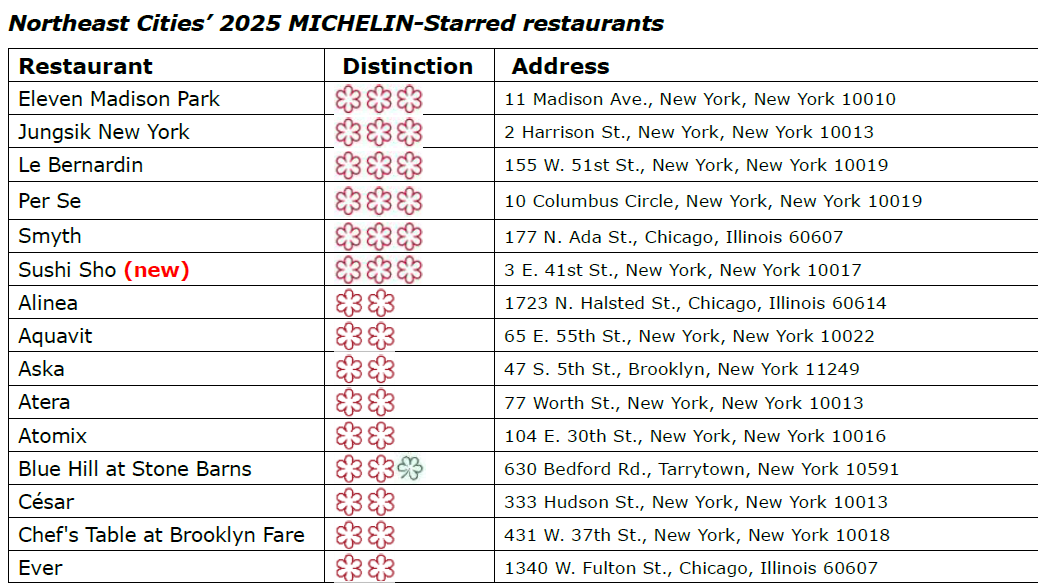
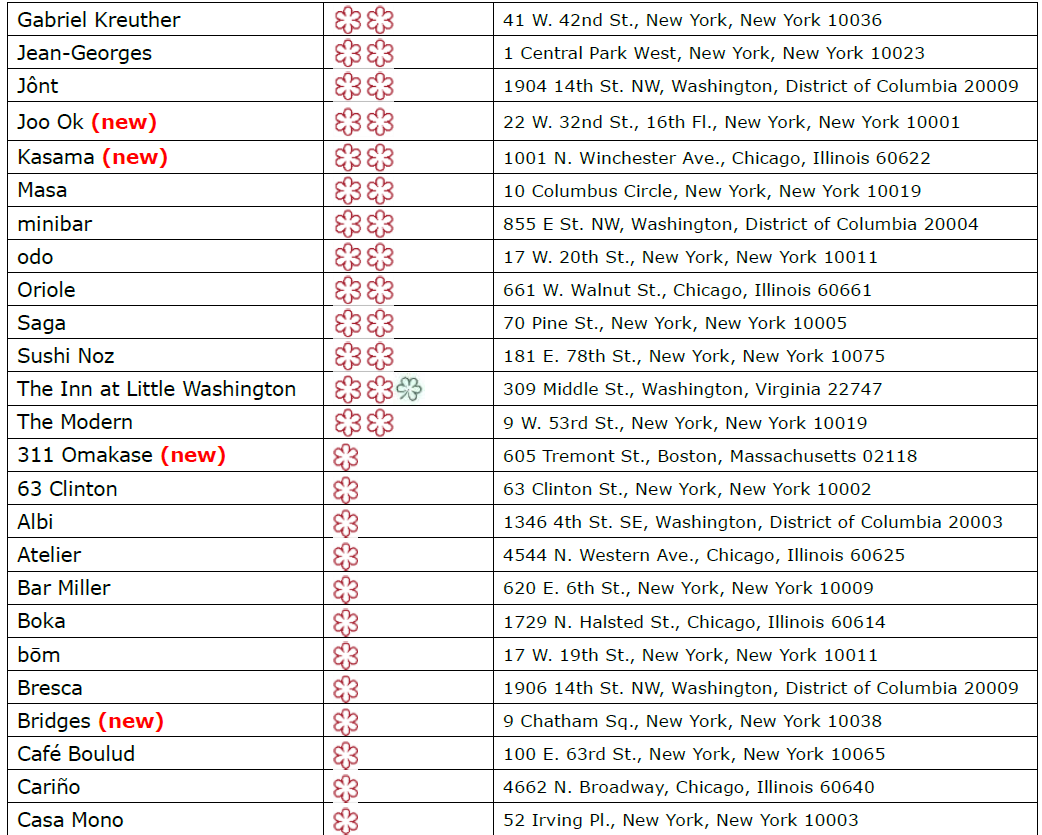
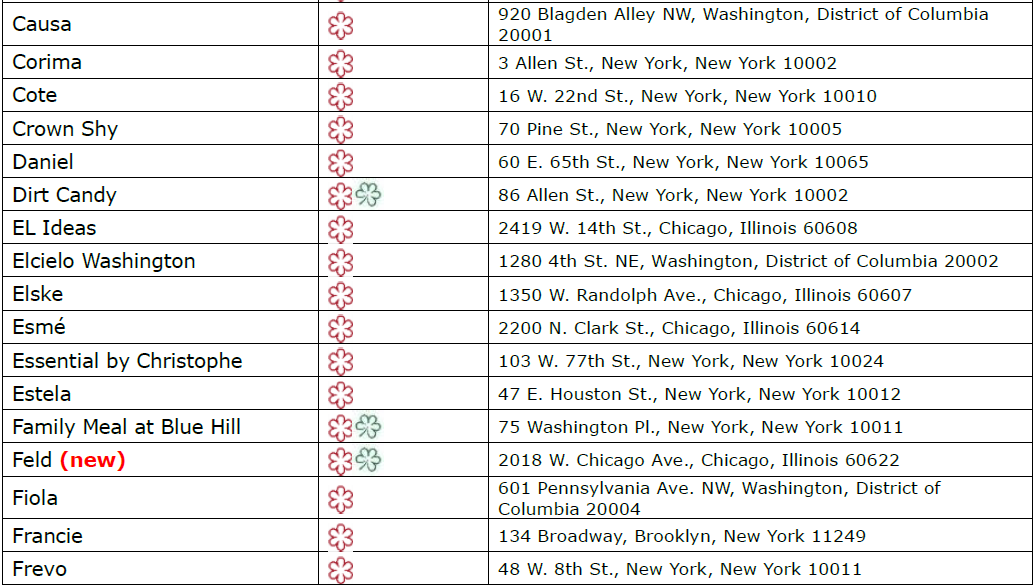
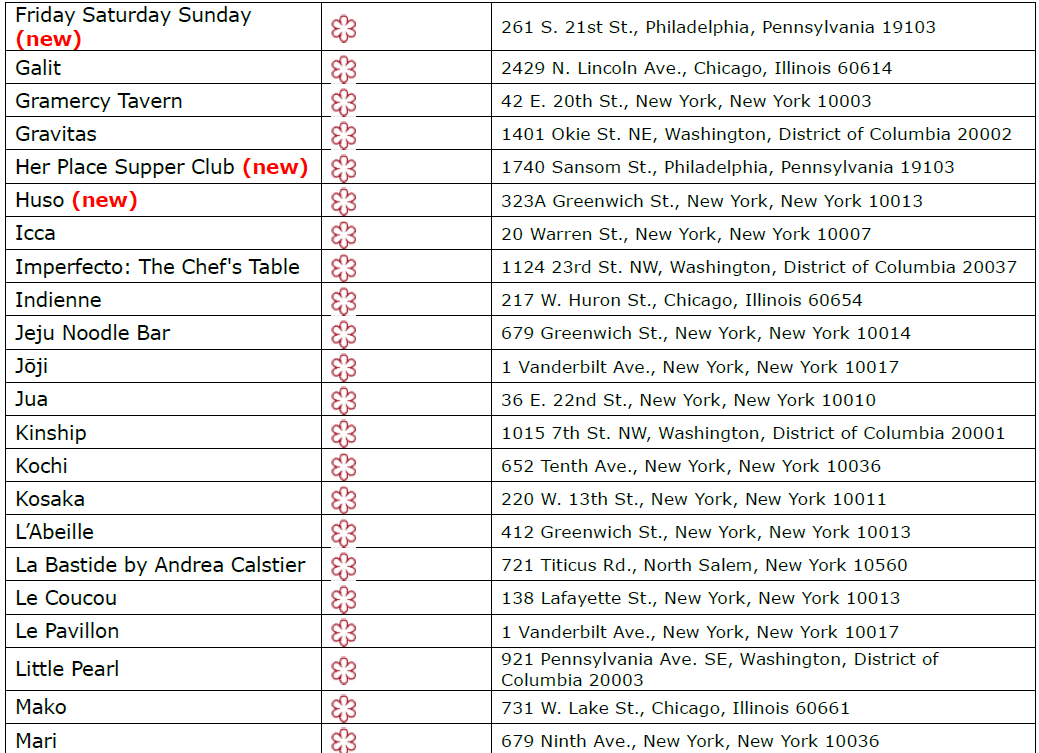


Northeast Cities’ New 2025 Recommended restaurants
NOTE: All restaurants in Boston and Philadelphia are considered “new” as this is the inaugural year for their selections. Restaurants listed below that are addressed in Chicago, New York or Washington, D.C. are “new” for the 2025 selection. The full list, including retaining recommended restaurants for Chicago, New York and Washington, D.C. can be found on guide.michelin.com.

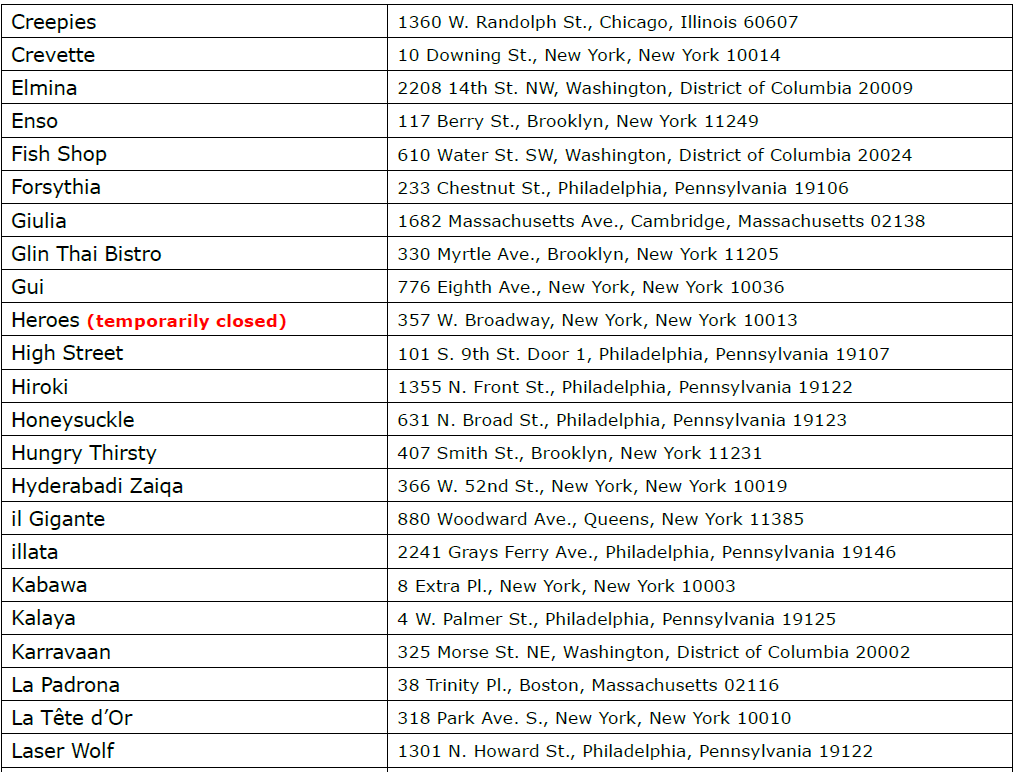


The MICHELIN Guide in North America
Michelin announced its first North American Guide in 2005 for New York. Guides have also been added in Chicago (2011); Washington, D.C. (2017); California (San Francisco in 2007, statewide 2019); Florida (Greater Miami, Orlando and Tampa in 2022, adding Greater Fort Lauderdale, The Palm Beaches and St. Pete-Clearwater in 2025, statewide in 2026); Toronto (2022); Vancouver (2022); Colorado (2023); Atlanta (2023), Mexico (2024), Texas (2024), Québec (2024), the American South (2025), Boston (2025) and Philadelphia (2025).
About the MICHELIN Guide
Recognized globally for excellence and quality, the MICHELIN Guide offers a selection of world-class restaurants.
The famous one, two and three MICHELIN Stars identify establishments serving exceptional cuisine that’s rich in flavor, remarkably executed and infused with the personality of a talented chef.
The Bib Gourmand is a designation given to select restaurants that offer good quality food for a good value – often known as personal favorites among the inspectors when dining on their own time.
The MICHELIN Green Star honors restaurants that are pioneers in sustainable gastronomy.
Recommended restaurants and special professional awards are also highlighted by the MICHELIN Guide inspectors.
The MICHELIN Guide remains a reliable companion for any traveler seeking an unforgettable meal and hospitality experience. The Guide was first published in France at the turn of the 20th century
to encourage the development of car mobility as well as tire sales by giving practical advice to motorists. Progressively, the Guide has specialized in restaurant and hotel recommendations. Michelin’s inspectors still use the same criteria and manner of selection that were used by the inspectors in the very beginning.
The restaurant selections join the MICHELIN Guide selection of hotels, which features the most unique and exciting places to stay around the world. Visit the MICHELIN Guide website, or download the free app for iOS and Android, to discover every restaurant in the selection and book an amazing hotel.
Thanks to the rigorous MICHELIN Guide selection process that is applied independently and consistently in more than 45 destinations, the MICHELIN Guide has become an international benchmark in fine dining.
All restaurants in the Guide are recommended by Michelin’s anonymous inspectors, who are trained to apply the same time-tested methods used by Michelin inspectors for many decades throughout the world. This ensures a uniform, international standard of excellence. As a further guarantee of complete objectivity, Michelin inspectors pay all their bills in full, and only the quality of the cuisine is evaluated.
To fully assess the quality of a restaurant, the inspectors apply five criteria defined by Michelin: product quality; mastery of cooking techniques; harmony of flavors; the personality of the chef as reflected in the cuisine; and consistency over time and across the entire menu. These criteria guarantee a consistent and fair selection so a Starred restaurant has the same value regardless of whether it is in Paris, New York or anywhere else in the world.
About Capital One
At Capital One we’re on a mission for our customers – bringing them best-in-class products, rewards, service, and experiences. Capital One is a diversified bank that offers products and services to individuals, small businesses and commercial clients. We use technology, innovation, and interaction to provide consumers with products and services to meet their needs. Through Capital One Dining and Capital One Entertainment, we provide our rewards cardholders with access to unforgettable experiences in the areas they’re passionate about, including dining, music and sports. Learn more at capitalone.com/dining and capitalone.com/entertainment.

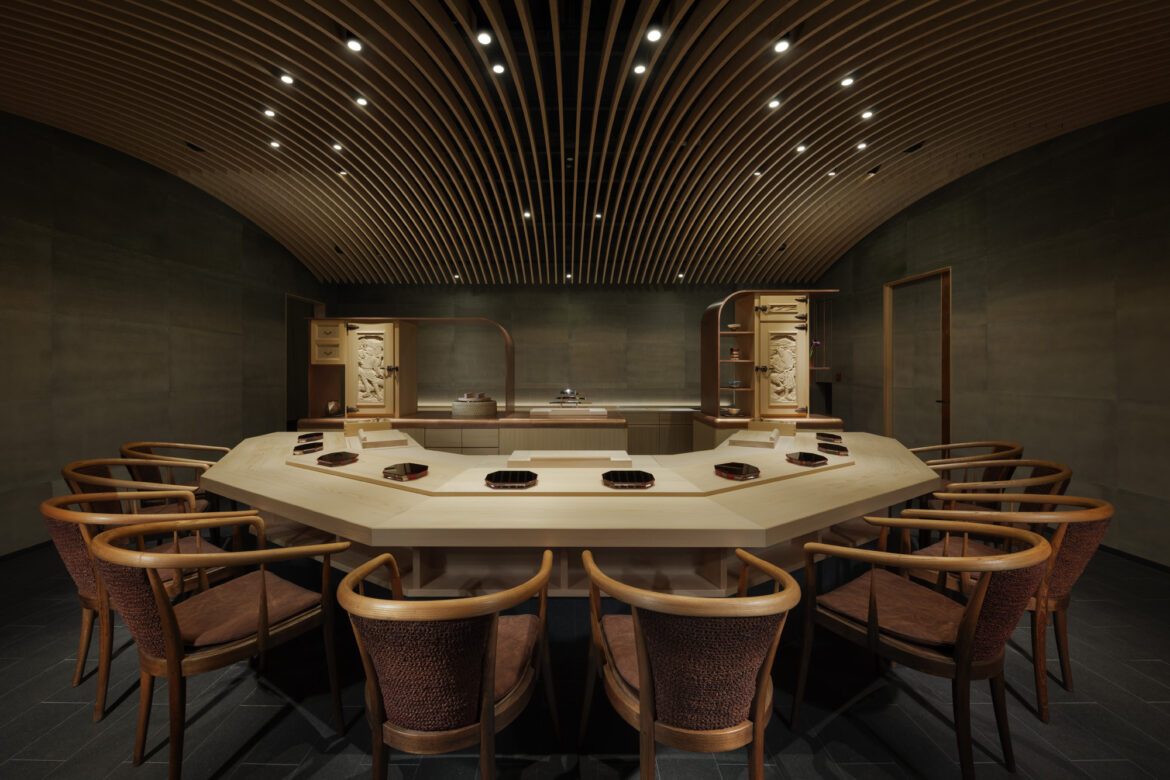
Dining and Cooking